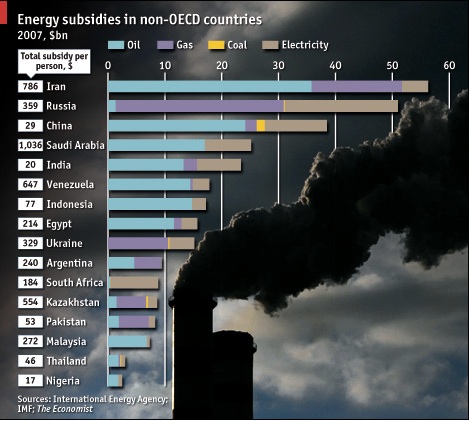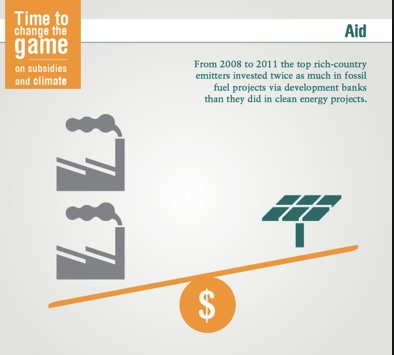Context
Imagine a pharmaceutical company produces a drug that makes us fell good now, and is cheap, but that after 25-50 years, makes our bones brittle, our muscles wither, and our minds subject to confusion depending on the temperature or dampness of the air so that we have to migrate to different climates. Would we agree to provide the company with a subsidy, say reduced taxes, so it can make more of the drug and higher profits? Probably not.
Once a consensus developed that cigarettes were deadly, to smokers and second-hand recipients, we did not provide subsidies to the cigarette makers so they could make more cigarettes and profits. Rather we added stark, indeed frightening, warnings to cigarette packaging and raised the taxes, and prices, to very significant levels to discourage usage.
You would think that these lessons would already have been applied to fossil fuels?
In the past, most people believed that it was a good idea to provide financial assistance, or subsidies, for the exploration, production, and distribution of fossil fuels. The policy was driven by a need to make energy supplies widely available, and cheap (not counting the climate and health risks), in order to provide heat and energy for comfort and economic growth. Subsidies provide incentives for people to produce and use fossil fuels, making it profitable for fossil fuel companies to explore and produce these fuels and for consumers to buy fossil fuels which would be much more expensive without the subsidies.
Now we recognize that the fossil fuels, particularly coal, oil, and gas, that we became dependent on are fouling the earth and changing the earth’s climate in quite dangerous ways. The subsidies have become counterproductive, even destructive. Besides incentivizing use of fossil fuels, these subsidies discourage investment in and use of renewable energy resources and efforts to develop energy efficiency. Why invest in renewables and insulation when oil, gas, and coal are cheap?
A number of agencies and groups have examined closely this issue of fossil fuel subsidies. The Global Commission on the Economy and Climate’s recent report,The New Climate Economy: Better Growth, Better Climate, calls for a phase out of subsidies for fossil fuels as part of its 10-point Global Action Plan. Oxfam has recently published a report, Food, Fossil Fuels and Filthy Finance, that connects the money flowing uninterruptedly to fossil fuel projects to food and climate risks.
Another recent report, which focuses exclusively on fossil fuel subsidies, is Time to change the game: Fossil fuel subsidies and climate, from the Overseas Development Institute (ODI). We will focus more closely at this ODI report.
Scope of the Subsidy Problem
The International Energy Agency (IEA) estimates that fossil fuel subsidies just for consumers, in 2012, were $630 billion for 42 developing countries; others have estimated fossil fuel subsidies for producers, which are more difficult to assess, at between $80 and $285 billion annually in developing and emerging countries. At 5-6. In contrast, for every $6 in fossil fuel subsidies, renewable energy received only $1 in subsidies.
What is most grievious about the fossil fuel subsidies is that they benefit the middle class and rich while the poorest 20% of households receive less than 7% of benefits from fossil fuel subsidies. At ii. Moreover, a number of countries, e.g., Egypt, Indonesia, and Venezuela, spend twice as much, or more, on fossil fuel subsidies as on public health. For example, in 2011, Venezuela spent almost $25 billion on fossil fuel subsidies and only a little more than $5 billion on health. Figure 8. In a vicious circle, subsidizing fossil fuels results in more people burning them and being sickened by them and so the health costs for the country escalate. Finally, the estimates of the amount of subsidies typically do not include the indirect, or external, costs, such as health or climate impacts. Including such costs, it has been estimated that the subsidies reach $1.9 trillion. See Oxfam report.
With such benefits at stake, it is no wonder that fossil fuel interests spent $213 million in 2013 in the US and EU, about $500,000 daily, trying to influence decision makers. Oxfam report.
Not only are regional and national governments paying fossil fuel companies to drill and sell more, but international financial institutions also invest much more in fossil fuel projects than in clean energy projects. The vicious circle widens.
If global action ended fossil fuel subsidies, even partially, that would reduce greenhouse gas (GHG) emissions by 360 million tones, equivalent to a 12% reduction in the level of GHGs needed to hold global temperature rise to 2°C.
The Fixes: What’s Missing
One of the basic problems of doing away with a fossil fuel subsidy is that there is no agreement on what constitutes a “subsidy.” Countries employ widely different financial instruments and policies to support fossil fuel industries and activities. Often it is in the form of tax breaks or concessions, but the tax systems of countries differ widely. Sometimes the subsidy is directed at particular sectors that rely heavily on fossil fuels, like farming, rather than or in addition to support for fossil fuel producers. Sometimes it is the form of building an oil reserve, or in allowing accelerated depreciation or reduced royalty payments. Clearly, each country can figure out how to change its tax and other laws to eliminate the subsidies, but a common definition is necessary to assure transparency and fairness in any international effort to end subsidies.
At least there are some starting points. For instance, the World Trade Organization (WTO) has used a definition of subsidy as “any financial contribution by a government, or agent of a government, that confers a benefit on its recipients.” It is very broad, and inelegant, but it could be a start.
Another point that needs clarification before a general solution to fossil fuel subsidies can be reached is the lack of data on exactly how much countries are spending on subsidies. That data is not widely known as there has been little reporting on or monitoring of the subsidies.
Further complications include impacts of subsidies, and elimination of them, on trade competition; the preservation of national sovereignty; and, efforts of governments to alleviate poverty since fuel costs are a major component of poor people’s budget.
The Fixes: What’s Possible
The ODI report offers a handful of recommendations for dealing with fossil fuel subsidies. First, of course, there has to be a global agreement to phase out all fossil fuel subsidies by a date certain. ODI suggests by 2025. To get things started, the ODI recommends that the G20 countries, which have already committed to phasing out “inefficient” fossil fuel subsidies, should expand that commitment to all subsidies. And, of course, the G20 has to actually honor the commitment.
Second, there has to be more concrete and wide-spread data collection and an agreed-upon definition of “subsidy” so that the phasing out will apply equally to the various forms of financial instruments and policies across countries and regions.
Third, to create an international effort, it is suggested that the G20 group lead the way to a complete phase out by committing to it, in 2015, and agreeing that each G20 country develop a national strategy on subsidy phase-out by 2014. In addition, the G20 could also coordinate its work with that of other international institutions, including the UN FCCC climate change negotiations, which hope to reach a step forward by 2015 in Paris, the WTO, and the work on the Sustainable Development Goals, all of which have a common interest in phasing out fossil fuel subsidies.
Fourth, there needs to be some international financial assistance to phasing out subsidies in developing countries. In developing countries, subsidies typically are consumption subsidies that make access to energy and fuel easier for the poor, in contrast to developed countries where the subsidies are often to fossil fuel companies to support production. The savings from ending the fossil fuel subsidies could provide funding for any consumer assistance in developing countries.
Fifth, there has to be some support for investment in low-carbon, clean energy technologies. It needs to be understood that clean-energy projects have to compete with historically and still artificially low energy prices based on fossil fuels, and the subsidies they received over the years.
Conclusion
So what’s the problem with taking such actions? Of course there is the aggressive and heavily funded lobbying attack by fossil fuel interests on any such measures. But we need to accept the reality that when subsidies are used to keep low the price of gas or oil, consumers also enjoy the benefits of those subsidies, and are reluctant to give them up. Just recall the public outcry, and political pressure, whenever gas prices go up significantly at the pumps.
But while the companies make money, and consumers save money, the earth is paying for it all. It’s time the earth called a halt to this deadly game of subsidized fossil fuels.
Sources
Shelagh Whitley,Time to change the game: Fossil fuel subsidies and climate, Overseas Development Institute (London, November 2013). www.climate-eval.org/sites/default/files/blogs/Fossil%20fuel%20subsidy.pdf
The Global Commission on the Economy and Climate, The New Climate Economy: Better Growth, Better Climate (September 2014). static.newclimateeconomy.report/TheNewClimateEconomyReport.pdf
Oxfam, Food, Fossil Fuels and Filthy Finance (October 2014). www.oxfam.org/en/research/food-fossil-fuels-and-filthy-finance
Oil Change International, Subsidizing Unburnable Carbon: Taxpayer Support for Fossil Fuel Exploration in G7 Nations (August 2014). priceofoil.org/content/uploads/2014/08/G7_exploration_subsidies.pdf
Oil Change International, “Fossil Fuel Subsidies: Overview” priceofoil.org/fossil-fuel-subsidies/
EDITORIAL UPDATE: 14 Nov 2014
The ODI has published a new report on fossil fuel subsidies, The fossil fuel bailout: G20 subsidies for oil, gas and coal exploration (November 2014):
Governments across the G20 countries are estimated to be spending $88 billion every year subsidising exploration for fossil fuels. This report documents, for the first time, the scale and structure of fossil-fuel exploration subsidies in the G20 countries. The evidence points to a publicly financed bailout for carbon-intensive companies, and support for uneconomic investments that could drive the planet far beyond the internationally agreed target of limiting global temperature increases to no more than 2ºC.
www.odi.org/publications/8678-fossil-fuel-bailout-g20-subsidies-oil-gas-coal-exploration
Regarding the ODI most recent study, the Guardian reported: “The most detailed breakdown yet of global fossil fuel subsidies has found that the US government provided companies with $5.2bn for fossil fuel exploration in 2013, Australia spent $3.5bn, Russia $2.4bn and the UK $1.2bn. Most of the support was in the form of tax breaks for exploration in deep offshore fields.”
“Rich countries subsidising oil, gas and coal companies by $88bn a year,” The Guardian (11 Nov 2014). www.theguardian.com/environment/2014/nov/11/rich-countries-subsidising-oil-gas-and-coal-companies-by-88bn-a-year





No comments yet, add your own below